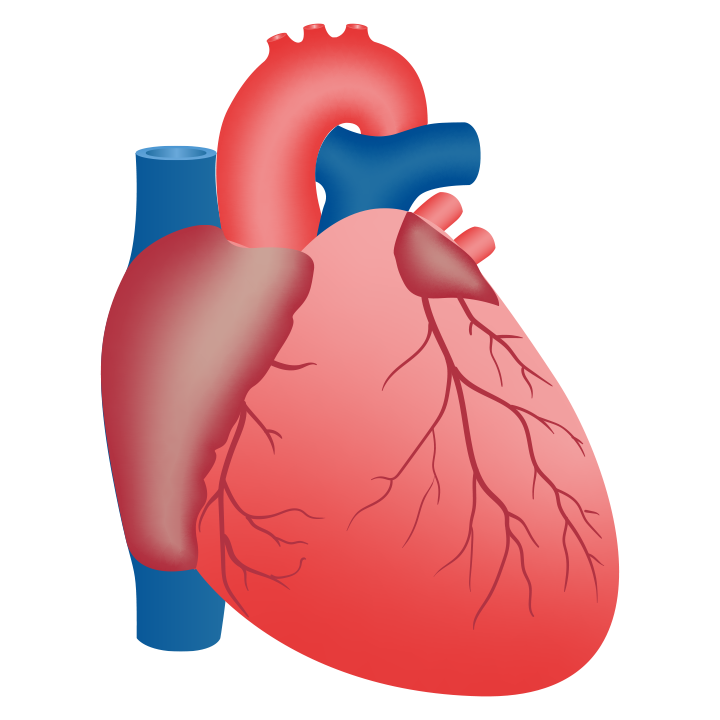
Heart failure / cardiac insufficiency - causes and therapy
What does the heart look like and how does it work?
Our heart is essentially a pump that pumps blood from the veins to the heart (right heart valve, small heart circuit, deoxygenated blood) and from the heart to the lungs (left heart valve, large heart circuit, oxygenated blood) and the aorta.
The heart is a muscle with various valves and can be compared to a high-performance pump.
For example, the heart of a female person weighing 70 kilograms pumps about 4.5 liters per minute through the body without physical exertion. This is about 6500 liters of blood in 24 hours.
What is heart failure or cardiac insufficiency?
In heart failure , the heart can no longer supply the body with sufficient oxygen and blood. If the heart now weakens, then a traffic jam occurs and this is similar to a highway where it goes from a three-lane road to a one-lane road. The result is a backlog. At the end of the single lane, fewer cars come out and the lane is thinly traveled. For the body, this means that congestion occurs in the supplying veins and too little oxygen-rich blood comes out the back. The first clinical signs include swollen legs.
Due to the fact that too little blood arrives in the aorta, the person is less physically resilient. This is another clinical sign.

What can be the causes of heart failure?
Heart failure can be caused by the following:
- Heart valve diseases, such as leakage or narrowing of the heart valves
- Inflammation of the heart muscle caused by viruses
- prolonged high blood pressure, which can overload the heart and weaken the heart muscles
- Cardiac arrhythmias caused by improperly functioning heart valves
- Diabetes due to unhealthy blood glucose levels
- Overweight and obesity due to the higher load on the heart from excess body fat.
- Smoking and alcohol abuse
What leads to heart failure?
The exact causes of heart failure can vary depending on the patient.
In general, weakening of the heart muscle means that the heart can no longer pump efficiently enough because too little blood reaches the heart muscle.
When the coronary artery is blocked, a heart attack often occurs, which is the death and scarring of the heart muscle. Both lead to a limited pumping capacity.
What symptoms can occur with heart failure?
- Shortness of breath, accelerated breathing
- Cough with foamy mucus
- Swollen feet and legs due to water retention
- Low physical resilience and rapid onset of exhaustion
- Palpitations, accelerated pulse


What can be done about heart failure?
- Healthy lifestyle
- Do not smoke
- Little to no alcohol
- Pay attention to the body weight
- Active daily life and regular physical activity
- Balanced and healthy diet
- Good social environment with good contacts to family and friends
If you notice the first signs of heart failure, you should consult a doctor immediately. You should consult a heart specialist if you have arrhythmia or valve disease.
In his Youtube video, Professor Albertus Scheule, MD, explains what heart failure or cardiac insufficiency is and answers the questions:
- What does the heart actually look like?
- What is heart failure?
- What are the most common causes of heart failure?
- What can be done about heart failure?
You are currently viewing a placeholder content from Default. To access the actual content, click the button below. Please note that doing so will share data with third-party providers.
More InformationMany diseases can lead to a reduction in the heart’s pumping capacity and the resulting increase in pressure. If the pressure in the veins increases, water is forced through the vein wall into the tissue in the pleural space and an accumulation of fluid occurs – also called pleural effusion!
Professor Albertus Scheule, MD, explains what a cardiac or heart-related pleural effusion is in his Youtube video and answers the questions:
- What is a pleural effusion?
- How does shortness of breath occur?
- Is it possible to get rid of pleural effusion?
- What to do in case of cardiac-related pleural effusion?
You are currently viewing a placeholder content from Default. To access the actual content, click the button below. Please note that doing so will share data with third-party providers.
More InformationNational Awareness Atrial Fibrillation Month
The month of September represents National Awareness Atrial Fibrillation Month and is intended to create awareness about cardiac arrhythmias and diseases.
With this blog entry, we also want to make a contribution and educate about heart failure and call for preventive examinations. This is because around ⅓ of all patients with heart failure suffer from atrial fibrillation. That is why prevention, such as a healthy lifestyle and preventive care, is all the more important.



